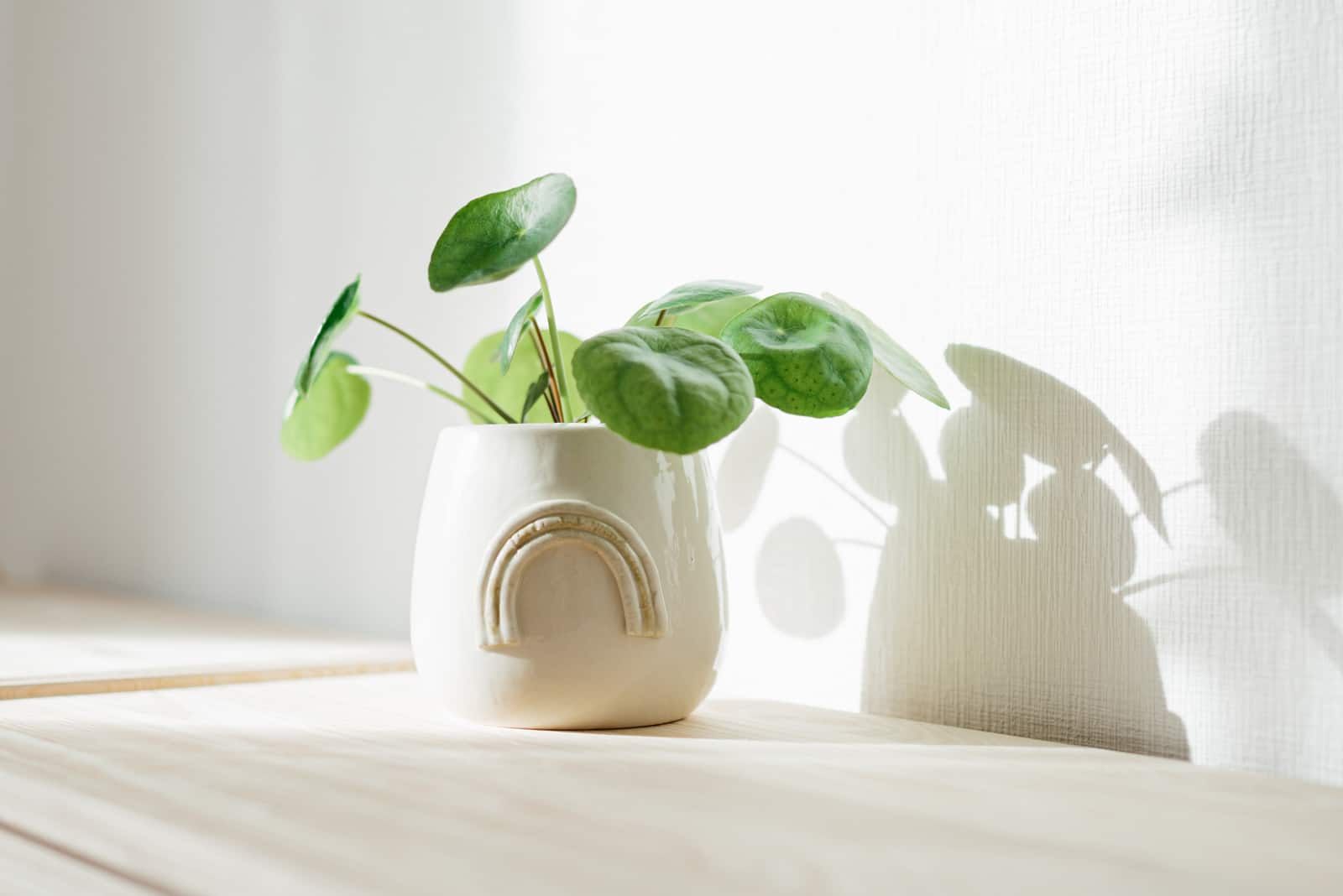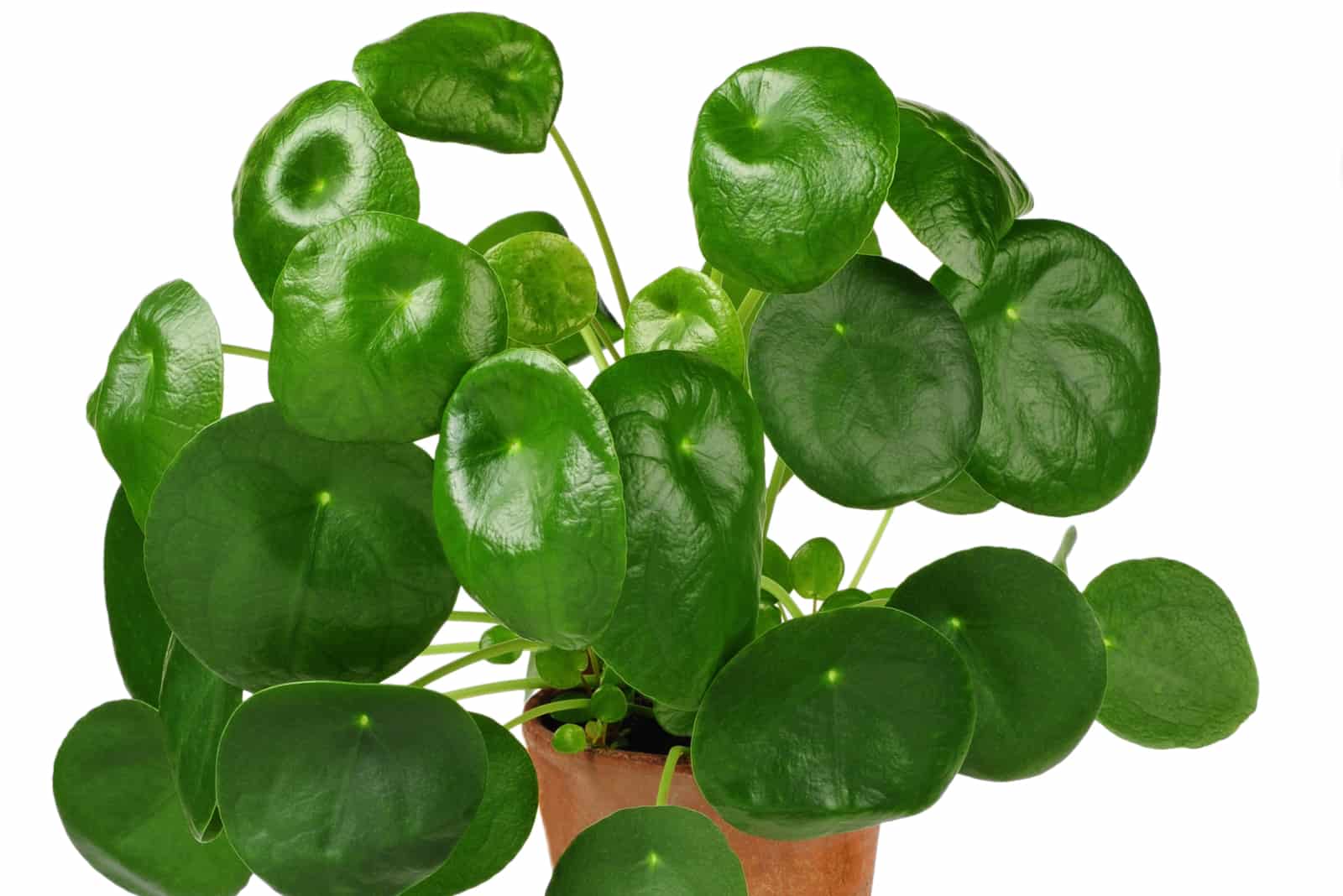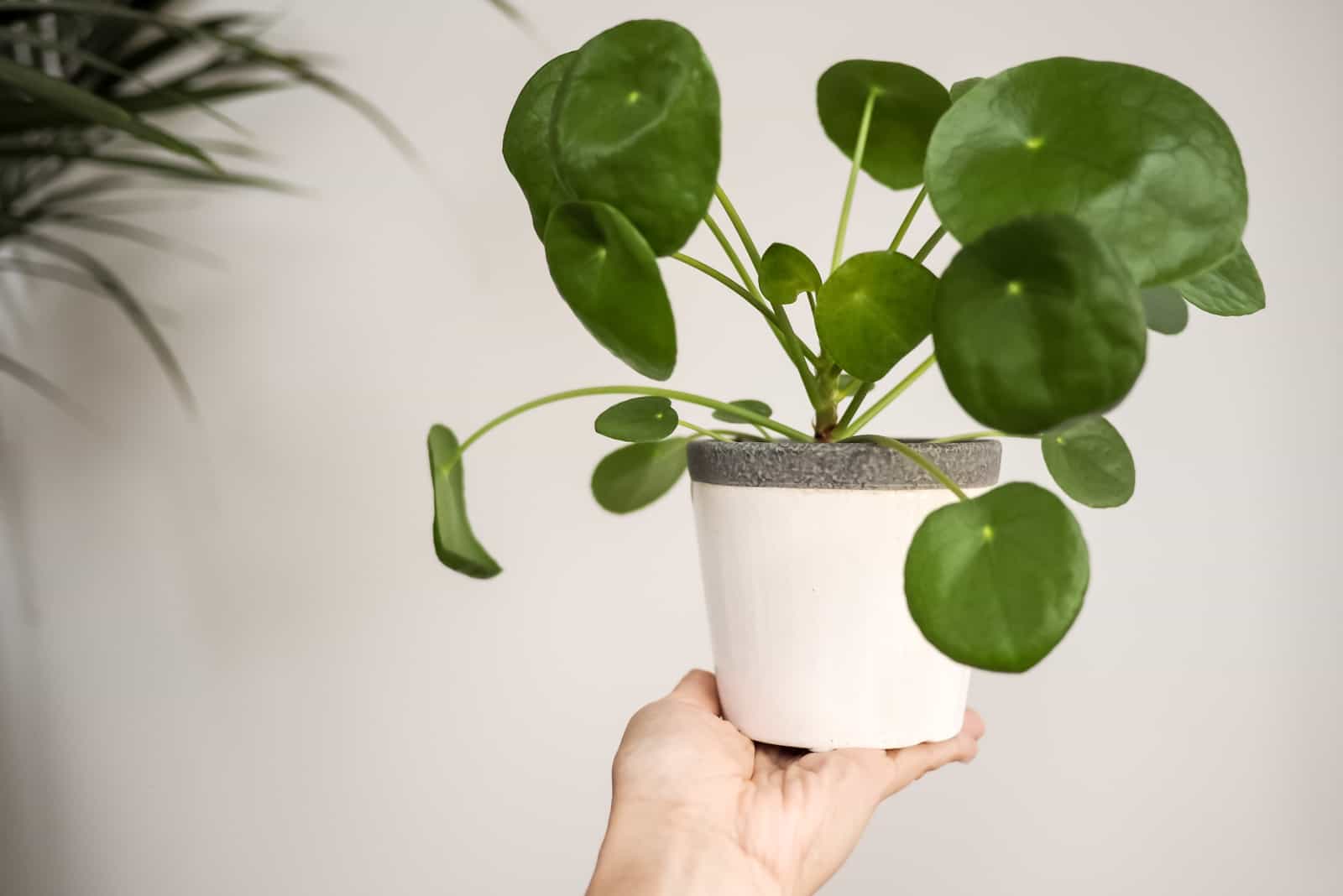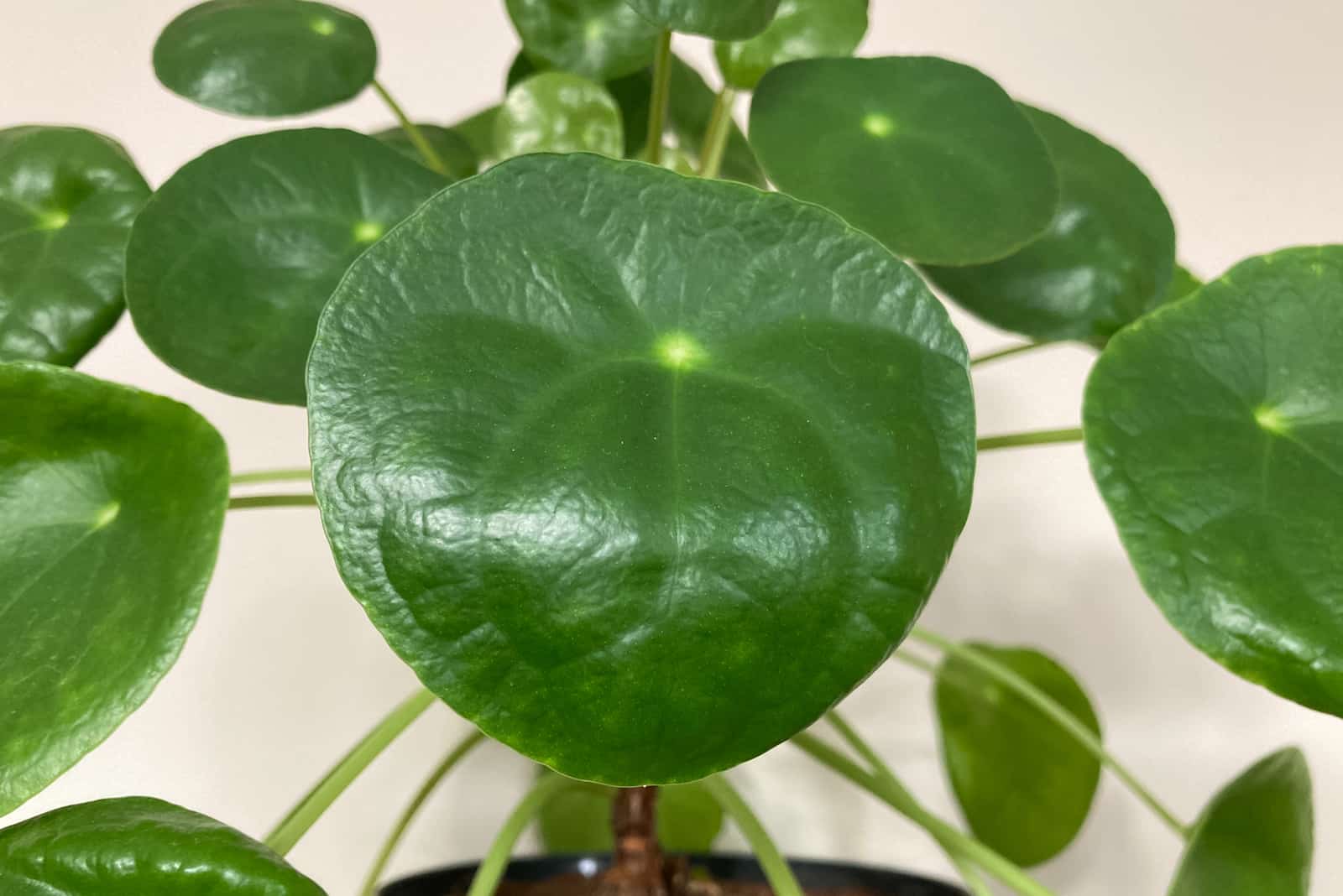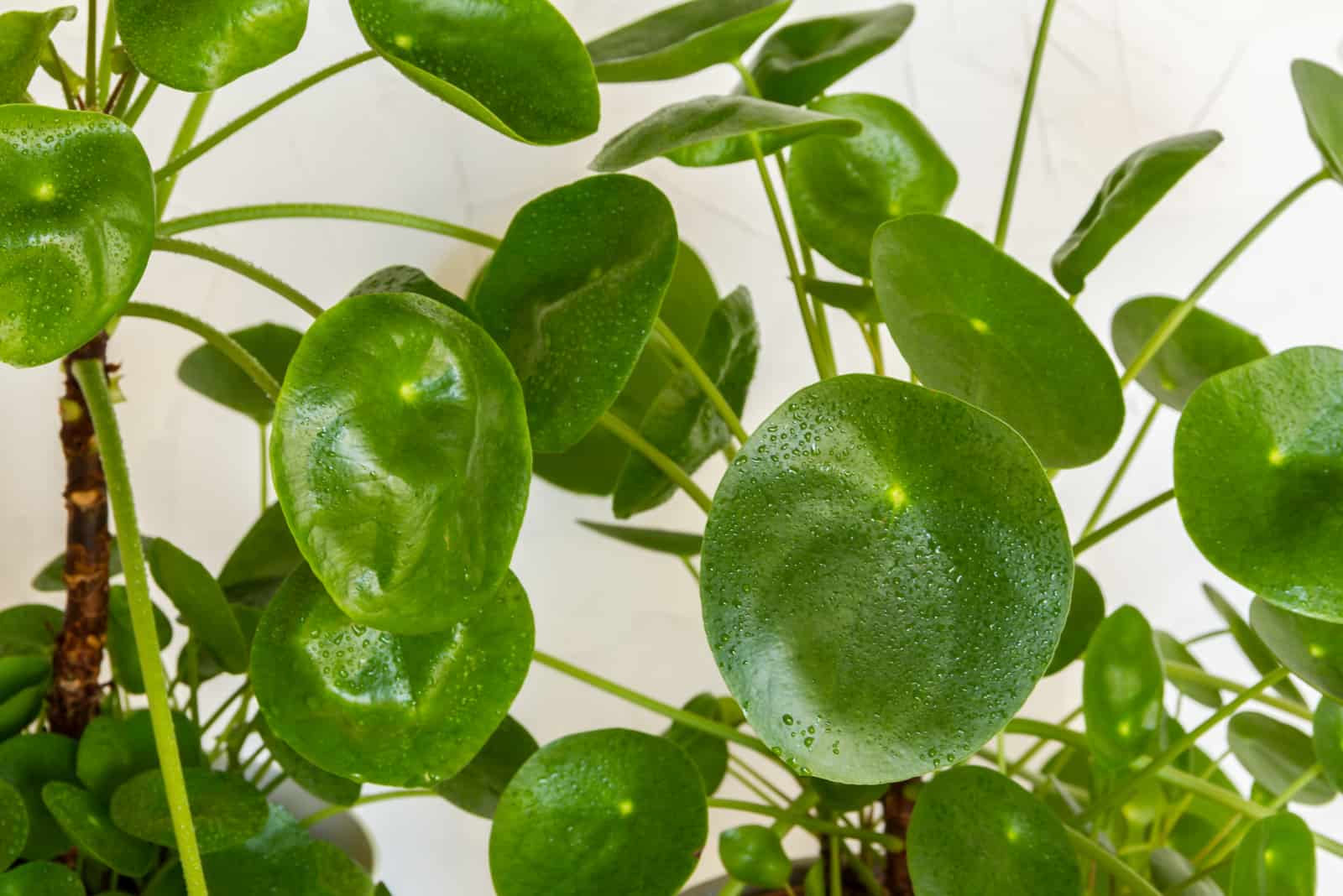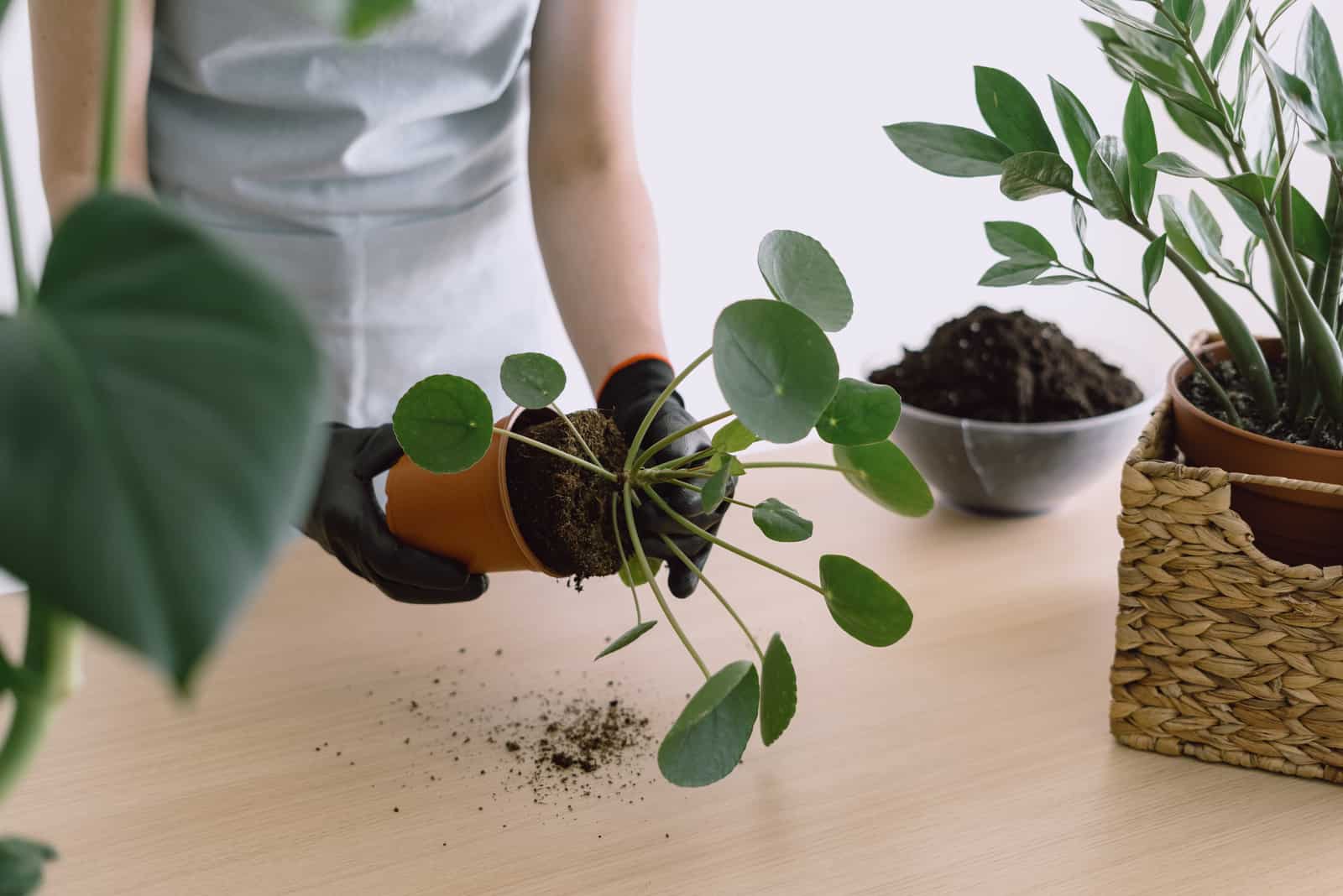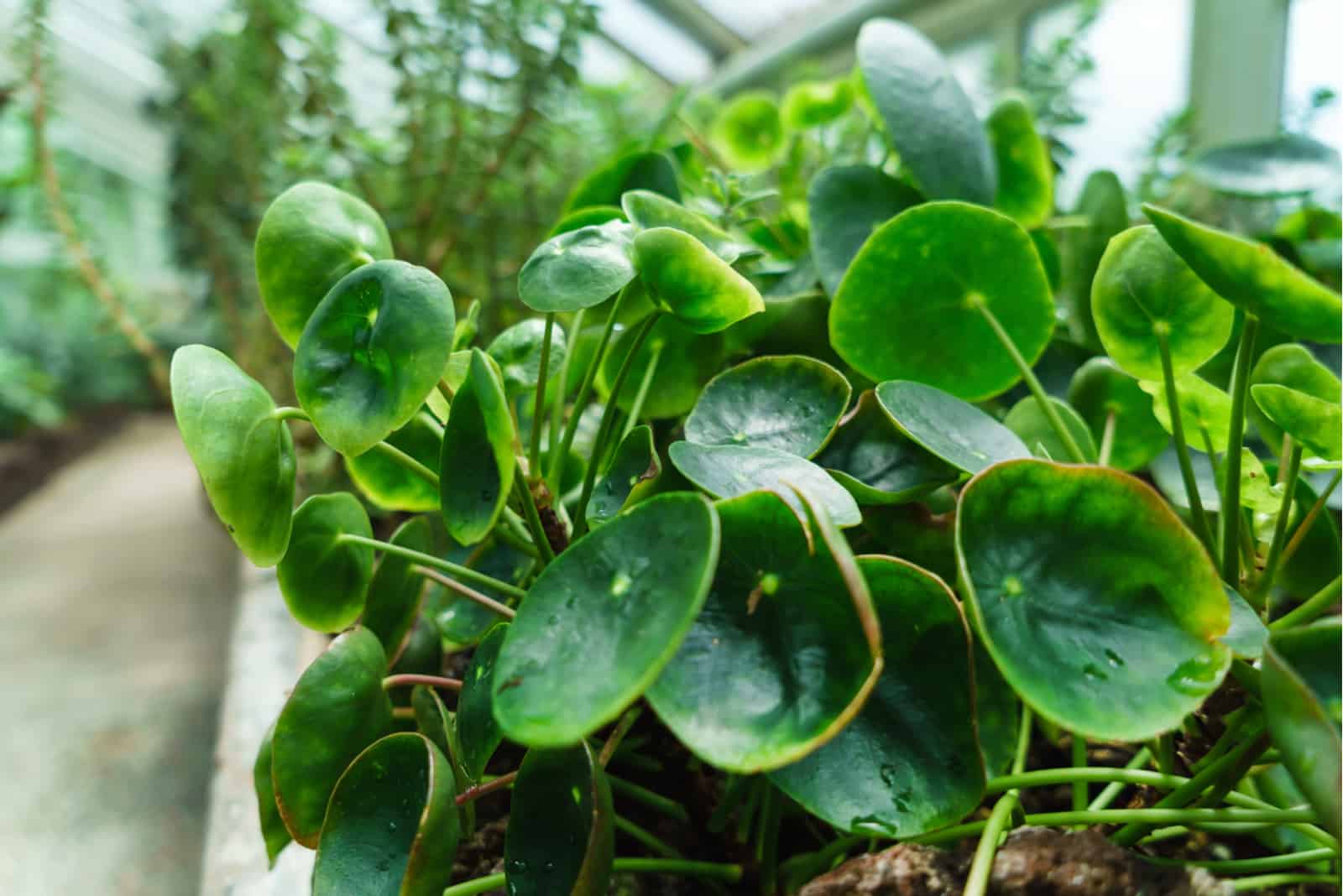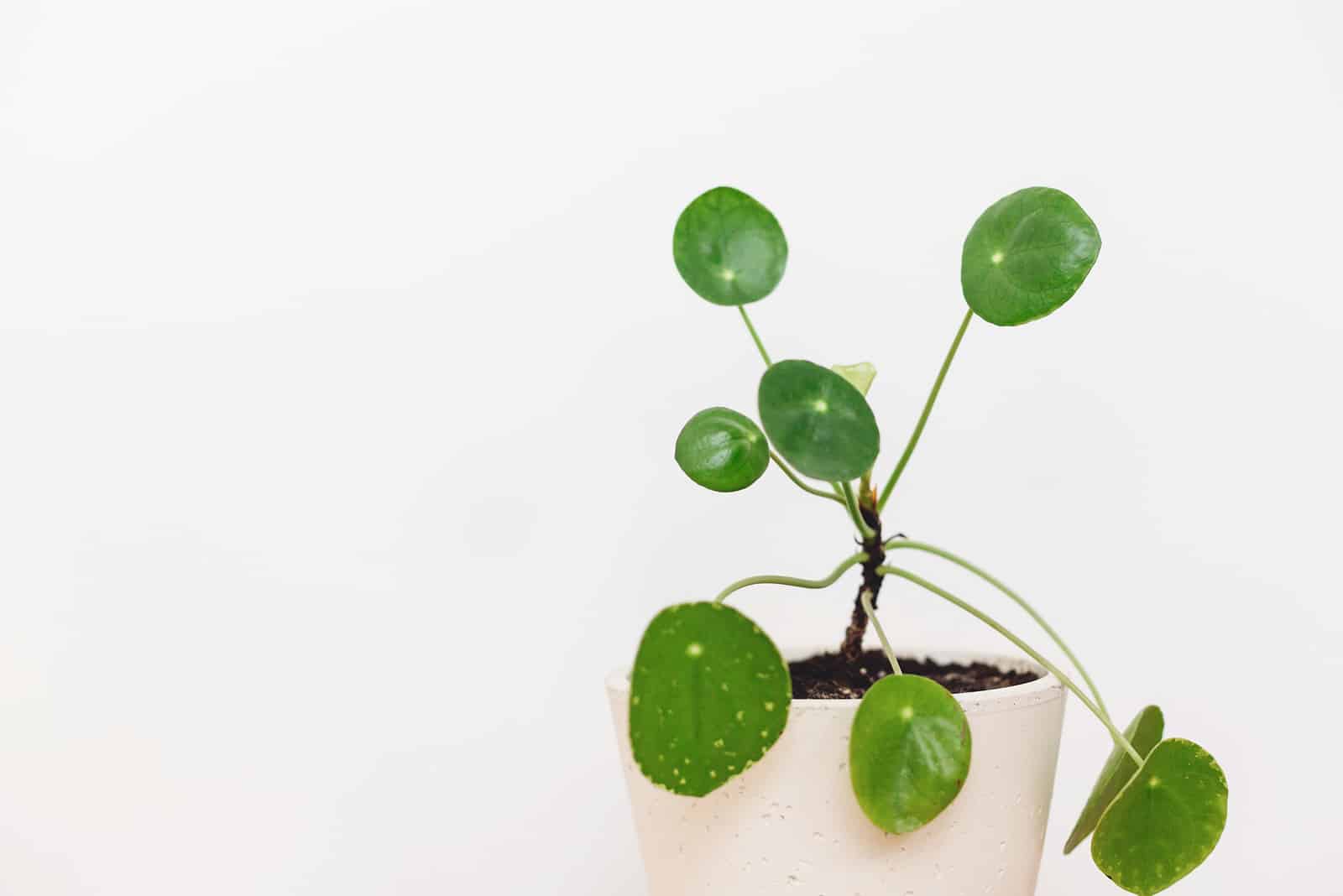Pilea Peperomioides, also known as, The Chinese Money Plant, has become a trendy houseplant. The reason for this is probably because coin-shaped leaves are believed to bring fortune and prosperity.
The problem arises when these coin-like leaves start curling. As curling occurs often, I’m sure you want to find out why.
If you’ve noticed Pilea leaves curling, be aware that it can be caused due to many reasons.
The most common causes include issues related to conditions, watering, or a normal life cycle. The good thing is that each reason has a solution!
Let’s get into details!
The Causes Of Pilea Leaves Curling
As mentioned earlier, curling can be caused due to various reasons.
To find out what lead to your Pilea leaves curling, review the table below to understand the different types of curling.
| Type Of Curling: | Common Causes |
|---|---|
| Doming or outward leaf curl: | Low light or overwatering |
| Cupping or inwards leaf curling: | Nutrient deficiency, underwatering, temperature or dry air |
| Cupping or inwards leaf curling: | Nutrient deficiency, underwatering, temperature or dry air |
| Leaf curl outward and inward: | Pests, diseases, nutrient deficiency, or overfeeding |
Now, let’s get into details!
Low Light Or Direct Sunlight
If you ever notice the leaves of the Chinese Money plant curl outward (doming), first check the level of light.
When the plant doesn’t receive enough light, the central part of the leaf pushes forward, creating a dome shape. Simultaneously, the leaf’s outer edges curl back.
If the level of light is too low, the leaves will expose as much surface area as possible to minimize photosynthesis, and consequently, they will curl.
On the other hand, direct sunlight will use up all water sources and cause water loss.
The roots won’t be able to transport water and nutrients to leaves, and they will curl.
This can be viewed as the plant’s defense mechanism; it reduces the plant’s surface area as it curls to protect itself.
Solution: Adjust Light
Place the plant in bright, indirect light. The plant needs sunlight, so place it near the window.
Bear in mind that direct sunlight can cause curling. Therefore, use a curtain on the window to create shade for the plant.
In this way, the Chinese Money Plant won’t be directly exposed to sunlight, and, at the same time, it won’t suffer from low light.
New Leaves Or Transplant Shock
During their lifecycle, it’s completely normal for Pilea Peperomioides to experience leaf curling.
New leaves will need some time to flatten.
The transplant shock refers to the state of the plant after repotting, transplantation, or relocation.
The plant hasn’t adjusted yet, and as a result, the leaves curl.
Solution: Give The Plant Some Time
If you notice leaves curling on top of the stem, there is no need to worry.
As the new leaves develop from the stem, they can only be seen curling on the top part of the plant.
Otherwise, if the rest of the plant is healthy, it give the leaves some time to flatten.
If your Pilea plant suffered from transplant shock, you should keep the soil wet and avoid fertilizing or pruning.
Overwatering Of Pilea Peperomioides
If you notice Pilea leaves curling downwards or forming a dome shape, you might’ve overwatered the plant.
The excess water will be absorbed by the leaves, causing the curling. The leaves expand to hold excess water and eventually curl.
If the leaves curl due to overwatering, you may notice other changes on the plant, such as the leaves turning yellow, waterlogged soil, or signs of root rot.
Solution: Stop Watering For A While And Change Habits
If you have determined that the leaves curl due to overwatering, stop watering the plants for some time.
Follow the tips below to fix the watering issue:
• Always check the level of moisture in the soil (use your finger, a wooden stick or a moisture meter)
• Use the same watering can you use for other houseplants (avoid using your sink, bathtub, or similar places around your house, where the danger of excess water for the plant is higher).
• Before watering the plant, bear in mind that leaves should not be watered. You can opt for bottom watering or water over the top of the soil. It is important to water carefully or you may risk overwatering or underwatering the plant.
• The temperature during winter is lower, so it’s essential to consider that it will need less water in the winter than during the summer season. Of course, you should always check the moisture level regardless.
• Never soak the entire plant; I suggest you water over the top of the soil and wait until the top inch of the soil is dry. Alternatively, apply bottom watering if you aren’t sure.
• Don’t pour the entire prepared amount of water immediately. Soak gradually and let the soil dry properly.
• I suggest you use distilled or filtered water. They don’t contain chemicals and toxins which can harm your plant.
Pilea Plant Leaves Curling Due To Underwatering
Opposite to overwatering, leaves can curl when they don’t receive enough water.
The leaves will reduce their surface area and water loss by curling.
Leaves will curl inward or upward due to underwatering. The plant might start to look limp, or it will droop.
Solution: Water More Often And Be Consistent
If you’ve concluded that the leaves curl is due to underwatering, give your plant a good soak.
Water more often until you see improvement, and stick to the watering schedule.
Bear in mind that the watering schedule requires changes as the conditions change.
Water is essential for the plant to grow healthy. Therefore, be consistent.
There are two mistakes that people make related to watering:
• Watering the plants prematurely,
• Waiting a long time in between waterings
Bear in mind that a plants lose water all the time, and that is why we have to consider that different conditions may affect plant needs for watering.
Humidity Levels
Leaves can curl due to low humidity.
The dry air will cause the leaves to lose water through transpiration. Consequently, the leaves will reduce their surface area to preserve water and eventually end up curling.
Although the Chinese Money Plant has some succulent features and tolerates lower humidity levels, it shouldn’t be kept in those conditions for too long.
Solution: Provide Moderate Humidity
As mentioned, the tolerance to low humidity decreases over time.
The plant needs moderate humidity of 40-50%.
If you’re not sure about the humidity level, you can use a humidifier to check.
Low Or High Temperature
Low temperature will disrupt the normal water movement to leaves.
If the water freezes, it can no longer move.
The leaves will respond by curling upward.
On the other hand, high temperatures will cause water loss, and as a result, leaves will curl upward. High temperatures will disturb plants’ physiology, especially water movement from roots.
The curling attempts to preserve moisture as the roots aren’t enough to compensate for the water loss.
Solution: Find A New Place For Pilea Peperomioides
The best option is to move the plant somewhere where you can regulate temperature levels (away from heaters).
If you keep the plant indoors, make sure that the place doesn’t have the following in the surroundings:
• Fireplaces
• Air conditioning products
• Radiators
• Stoves
On the other hand, if you keep your Pilea outdoors, be sure to provide some form of shade.
Lack Of Nutrients Or Too Much Fertilizer
If you notice Pilea leaves curling downward or upward, the plant may be suffering from a nutrient deficiency or overfeeding.
Calcium or Phosphorus deficiency will cause the leaves to curl downward.
If the plant lacks only Calcium, the leaves will curl upward.
Another cause of curling can be nitrogen deficiency.
If the leaves have too much nitrogen, they will curl downwards.
Yellow leaves may also arise if the plant lacks nutrients. The combination of yellow leaves, curling, stunted growth and discoloration requires changes in feeding procedure.
Solution: Change Feeding Habit
There are three solutions to fertilizing:
• Use an all-purpose 20-20-20 fertilizer and dilute it to half it’s strength. As this is a liquid fertilizer, you should water the plant afterwards. Alternatively, use 14 14 14 or 17 17 17 fertilizers.
• Apply fertilizer during the growing season (spring and summer).
• If you accidentally overfeed the plant, flush or leach the soil.
Pests And Diseases
A pest infestation can cause the leaves to curl downwards or upwards or even thicken and get ruffled.
Four common types of pests can cause curling:
1. Spider mites (cause the appearance of tiny spots on the leaves that can be either brown or white).
2. Aphids (honeydew on the undersides of the leaves).
3. Mealybugs (cause cotton-like changes on the leaves).
4. Scale insects (look like shell bumps on the undersides of the leaves).
These pests will extract juices from your Pilea plant leaves, leading to water loss. Additionally, they may inject toxins and cause more damage to the plant.
The diseases that can cause curling of the Pilea plant leaves are leaf spots, powdery mildew, root rot, and botrytis.
When it comes to diseases, root rot is the most common cause. Apart from curling leaves, other signs can help you determine if the plant suffers from root rot. Yellow leaves, waterlogged soil, or brown spots on the leaves of the Chinese Money Plant will occur after the root starts to rot.
Solution: Remove Pests And Root Rot
You can use a couple of methods to get rid of the pests. Firstly, you can try to dislodge them by using water or cleaning the leaves by rubbing alcohol. If the infestation is severe, you can use insecticidal soap, horticultural oil, or neem oil.
Root rot can be removed with sterilized scissors or pruners after taking the plant out of the pot. Repot the plant and water it.
We won’t get much into details as far as the other dangerous diseases are concerned.
However, the best thing you can do is to prevent them. You can find the best ways to prevent diseases that cause Pilea leaves curling in the section: What Can I Do To Prevent My Pilea Leaves From Curling?.
Rootbound Chinese Money Plant
How can rootbound cause curling of Pilea Peperomioides’ leaves? The rootbound occurs after the plant overgrows the pot.
The plant doesn’t have enough soil and the roots can’t uptake the nutrients and water from it.
Consequently, as the leaves don’t receive enough water, they reduce their surface area.
As a result, they curl.
Rootbound doesn’t only cause curling, but also Pilea plant drooping.
Solution: Repot The Pilea Indoor Plant
When you notice the plant outgrows the pot, the best thing you can do is to repot the plant into a larger pot. There are three things to consider when repotting, and here’s the list.
1. First, choose the right pot. The pot should not be too large because if there is more soil around the root system than there should be, the soil will retain excess water and become mushy. We suggest buying terracotta pots instead of plastic ones.
2. Pay attention to drainage holes and potting mix: all excess water must be drained from the soil to avoid root rot.
3. Large pots need more soil. Hence, watering needs to be adjusted as there is soil around the root system. In other words, watering should occur less frequently in this case.
What Can I Do To Prevent My Pilea Leaves From Curling?
To prevent leaves from curling, you have to pay close attention to plant care.
Here is a table pertaining to care tips that help avoid Pilea leaves curling.
| Temperature requirements | The best temperature should range from 65°F to 75°F. The Pilea plant can also tolerate 55°F to 86 °F. |
| Humidity requirements | The plant requires high humidity: 50-75%. |
| Lighting requirements | The plant will thrive in bright, indirect light. |
| Soil mix and required pH | 5.0 to 6.0 (slightly acidic). Add coco coir, peat moss, or perlite (pumice or orchid bark) to achieve well-draining soil. |
| Watering schedule | Twice a month is preferred, but it should be adjusted to the environmental conditions, size, and potting mix. |
| Fertilizing | Once a month will work. Choose all-purpose 10-10-10 liquid fertilizer or 20-20-20, half strength |
| Pruning | Using sterilized pruners, cut dead or damaged leaves. Cut some branches off if you want to control shape or growth in the growing season (spring or summer). |
| Repotting | Chinese Money Plant should be repotted every two years. If the plant outgrows the pot, it should be repotted more often. Repot during spring or summer. |
| Propagation | If you want to produce new growth, you can propagate the plant by stem cutting or offshoots (plantlets) |
FAQs
What does an overwatered pilea look like?
An overwatered Pilea has drooping, falling, or yellow leaves at the beginning. If overwatering continues, you may notice Pilea leaves curling, moldy soil that has an unpleasant smell and the plant will have a wilting appearance.
What is the lifespan of a pilea?
Pilea Peperomioides plants live around 10 years. This is the average lifespan of the plant if it’s provided with all required conditions. If some issues occur and the plant is not treated, its lifespan significantly reduces. On the other hand, if you give it some extra care and attention, it can live more than 10 years; some claim that their Pileas lived for 20 years.
Wrapping Up
I know you felt scared when you noticed curled leaves on your Pilea plant.
There are many causes of Pilea leaves curling; now that you know them, determine which one your Pilea has. Use our methods to fix the problems.
Looking after the Chinese Money Plant is very rewarding, but not always easy, so now you should be well equipped to do so.
Until next time!

